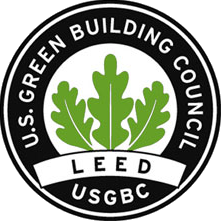

“More and more companies are seeking LEED certification because of LEED’s positive impact on the triple bottom line – people, planet, profit. Every day 2.2 million SF is LEED certified and to date, there have been nearly 37, 800 projects in 165 countries and territories that have achieved LEED certification.
The 2015 Green Building Economic Impact Study found that the green building industry contributes more than $134.3 billion in labor income to working Americans. The study also found that green construction’s growth rate is rapidly outpacing that of conventional construction and will continue to rise.
By 2018, green construction will account for more than 3.3 million U.S. jobs–more than one-third of the entire U.S. construction sector–and generate $190.3 billion in labor earnings. The industry’s direct contribution to GDP is also expected to reach $303.5 billion from 2015-2018.”
These are the stats as of May 2017:
| Certification Level | Number of Projects | % of Projects | Gross Square Footage | Gross Square Meters | % of Gross Area |
| Certified | 8,006 | 21% | 775,867,064 | 72,080,378 | 13% |
| Silver | 12,281 | 32% | 1,617,989,303 | 150,316,060 | 28% |
| Gold | 14,867 | 39% | 2,891,364,292 | 268,616,417 | 49% |
| Platinum | 2,643 | 7% | 562,563,752 | 52,263,860 | 10% |
“USGBC does not certify, endorse or promote products, services or companies, nor do we track, list or report data related to products and their environmental qualities.LEED changes the paradigm for how decisions are made about materials that go into the buildings we spend so much of our time in by giving new information to decision makers.
Usage: Within the Materials and Resources (MR) section, instead of saying a product is good or bad based on one attribute, e.g. recycled content, LEED enables project teams to have a more robust dialogue with manufacturers about optimizing around environmental, social and health impacts and better understand trade-offs. This category is designed to consider the entire life-cycle of the building, from extraction and manufacturing, to transport, operations, and maintenance and eventually the end of life.
Life-cycle: Whole building life-cycle assessment encourages the architect to work with the structural engineer to investigate opportunities to reduce the embodied energy of materials by right-sizing the building’s structure. There can be as much as a 20-30 percent positive impact on the life cycle of the building by looking at bay sizing and slab depth. This is important because as buildings become more and more operationally efficient, the embodied impact of materials gets proportionally larger.
Transparency: Environmental product declarations and material ingredient reporting tools, like Health Product Declarations, provide architects and designers more information on the contents in products and the manufacturing process. EPDs address how products are made, their material ingredients, and other tools provide information about who makes them. These three together address the triple bottom line and give architects a more complete set of information by which to select products.
By providing this information, manufacturers can better differentiate the progress they’ve made and demonstrate that improvement. LEED is a certification system that deals with the environmental performance of buildings based on overall characteristics of the project. We do not award credits based on the use of particular products but rather upon meeting the performance standards set forth in our rating systems. It is up to project teams to determine which products are most appropriate for credit achievement and program requirements.”
